A guide to cutting petunia in the summer for novice gardeners
Petunia is a beautiful, unpretentious plant that blooms from early spring until frost. Having purchased planting material once, the crop can be propagated an unlimited number of times by cuttings or seeds.
Most gardeners prefer cuttings, as it allows you to quickly obtain developed flowering seedlings, regardless of which mother plant is used - hybrid or varietal. The results of growing from seeds are unpredictable: the characteristics of the hybrid are rarely transferred to the seeds, and the inflorescences are easily cross-pollinated.
Read on to learn how to propagate petunia from cuttings for the winter.
Features of petunia cuttings in summer
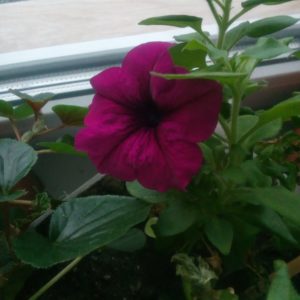
In summer, the plant is in a state of active growth, takes root easily, and when cuttings it turns out strong and healthy. Next spring it will already be a blooming, spreading bush.
It is recommended to take petunia cuttings when it continues to bloom, but summer is already ending. Most gardeners cut planting material in August.
The part that remains after cuttings will die during night frosts. After the cuttings are separated from the bush, they immediately begin rooting. If you hesitate, the material will wither.
When cutting petunia at home in the summer, the seedlings take root most quickly and grow a strong root system. This period is considered the most favorable.
Advantages and disadvantages
Cuttings have many advantages:
- Preservation of plant characteristics. It doesn’t matter whether the hybrid or variety was used, the cutting will produce an almost exact copy of it.
- Speed. Seedlings obtained from seeds develop extremely rarely. Petunia grown from cuttings, will bloom within 2 months after planting.
- Strong root system that is forming with the vegetative method of propagation.
- Low maintenance requirements. Cuttings survive gardener mistakes more easily than seedlings.
- Saving. This flower propagation is cheaper than buying ready-made seedlings and seeds of the variety you like.
There are not many disadvantages. Firstly, the collected planting material will have to be stored all winter, creating optimal conditions for it. Secondly, if the cuttings are processed incorrectly, the seedlings may get sick.
Deadlines
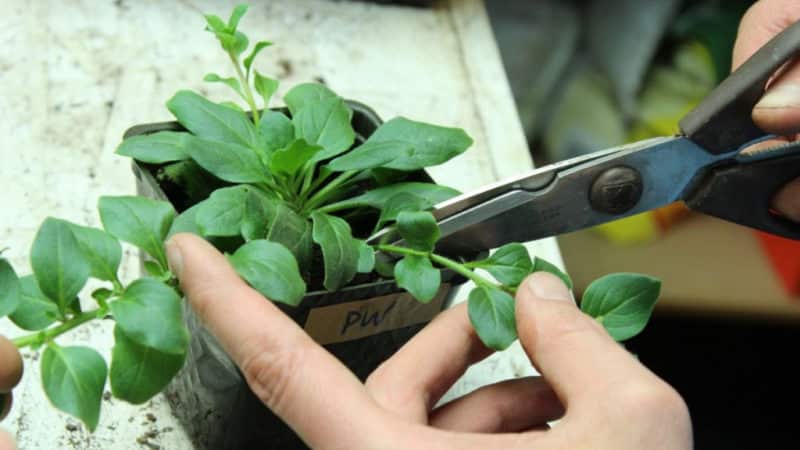
Any time of year is suitable for cuttings. Approximate time frame for this procedure:
- Summer. It is considered the most suitable period. Cuttings are carried out in August.
- Winter. To obtain cuttings, you will have to keep the petunia at home throughout the winter. The best time for the procedure is February.
- Spring. A plant that has stood at home all winter is suitable for cuttings. The optimal time is early March.
- Autumn is the most inappropriate period, as all life processes of the plant slow down. If necessary, they try to collect planting material in September.
Mother plant selection
For rooting to be successful, it is important to choose the right mother plant. Its main parameters:
- spreading flowering bush with bright foliage;
- the plant is strong and healthy (specimens with spots, damage and other signs of disease are not suitable);
- Petunia bloomed actively all season and did not get sick.
Plants that have recovered from the disease are weak and have low immunity. Often their cuttings do not take root.Even if such planting material takes root, the risk that it will get sick is great.
Bushes that bloomed profusely and developed quickly will produce the same planting material. Cuttings from weak plants will have few flowers.
Selection and preparation of cuttings
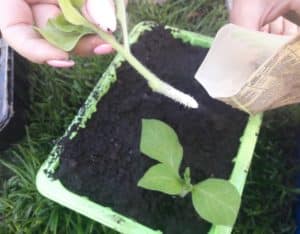
It is better to take planting material from the top of the plant. It will grow and develop faster. The branches should be bright in color without damage.
How to cut petunia:
- 6–12 cm extend from the end of the selected branch. If you take a shoot of greater or lesser length, rooting it will be problematic. The resulting cutting should have from 4 to 6 leaves. The most powerful branches on the plant are suitable for propagation.
- The cut is made at an angle of 45°. The cut site is not processed.
- After receiving the planting material, they immediately begin to root it. Within a day, the cutting will wither and become unusable.
Preparation for planting includes the following procedures:
- A scrap of leaves. The top 2 leaves are left on the cuttings, the rest are removed.
- Disinfection. The material is soaked for 15 minutes in a light pink solution of potassium permanganate.
- Stimulation of root formation. To do this, the seedling is soaked for a day in a Heteroauxin solution prepared according to the instructions (2 tablets per 1 liter of water).
If you do not disinfect the cuttings, there is a risk of infecting other indoor plants.
Rooting methods
There are several ways to root petunias. Some require the purchase of a special substrate for planting, while for others, familiar materials are sufficient. All options have different planting technologies and are actively used by flower growers.
In the ground

Rooting petunia in the ground - the most popular and reliable method. All varieties of this plant take root well and easily tolerate picking.When using this method, the flower will not experience stress during transplantation.
For rooting you will need a light but nutritious substrate. A universal mixture for flowers is suitable. Many gardeners prepare the soil themselves from peat, sand and garden soil (2:2:1). According to reviews, to improve the effect, it is better to replace sand with vermiculite.
Attention! The soil mixture uses soil taken from the place where the petunia will grow. Then the flower will easily transfer the pick to open ground.
Be sure to use drainage: broken bricks, small expanded clay, crushed ceramics.
The soil and drainage are disinfected. To do this, use one of the methods:
- pour boiling water or a dark pink solution of potassium permanganate;
- calcined in the oven or in a frying pan;
- water with a solution prepared from 1 tbsp. l. copper sulfate and 10 liters of water.
Peat pots, small disposable cups or cut-off bottles are used as containers. To create a greenhouse effect, you will need a transparent cellophane bag or the top of a plastic bottle (it is more convenient to use, since for ventilation you just need to unscrew the cap).
Step-by-step instructions for rooting petunia in the ground:
- A layer of drainage is poured onto the bottom of the container. The rest of the space is filled with soil. The soil is moistened with warm water.
- The cuttings are planted in the ground, deepened by 1.5–2 cm. They should stand without support, but so that the leaves do not touch the ground.
- The cutting and container are covered with film or a cut bottle. The resulting “greenhouse” is ventilated daily for 15 minutes.
- The seedlings are watered as the soil dries with warm, settled water. Liquid should not fall on the above-ground part of the plant. After each watering, sprinkle the soil with dry sand.
Rooting is indicated by new leaves beginning to form on the seedlings. From this moment on, the duration of ventilation is increased. Soon the “greenhouse” is dismantled.
Transplant the plants together with the earthen ball into larger containers when the roots fill the entire space.
Attention! Some gardeners root cuttings in a common container. In this case, they are planted as soon as roots form. The disadvantage of this method is that if one plant is infected with blackleg, all of them will become ill.
In water
This method does not require soil preparation and a lot of time for planting. Seedlings are planted in separate pots immediately after roots appear.
Rooting in water is not suitable for all varieties of petunias. There is a risk of rotting of planting material if technology is violated.
Therefore, it is important to follow the instructions:
- Select cuttings no shorter than 8 cm. As in the first case, all leaves, except the top two, are torn off.
- The glass is filled halfway with water. A tablet of crushed activated carbon is dissolved in the liquid. This will reduce the risk of planting material rotting.
- Place 1-2 branches in each glass. They are covered with film or a cut bottle and put in a warm, dark place.
- Every day the film is removed and the plant is ventilated for 15 minutes. As the water decreases, it is added.
When roots appear on the seedlings, they are transplanted into individual pots without deepening the root collar.
In vermiculite and hydrogel

Vermiculite provides the cuttings with enough air, moisture and nutrients to take root. The landing goes like this:
- Vermiculite with a fraction of 1-2 mm is poured into the container. The height of the layer should be 3–5 cm. The substrate is saturated with water, allowing the excess to drain through the drainage holes.
- The cuttings are immersed in vermiculite and covered with film. It is ventilated daily for 15 minutes. Drops of liquid are carefully removed from the film.
- When the seedling has grown roots, it is transplanted into an individual container.
Seedlings are grown in hydrogel using the same principle. The substrate is first saturated with water so that it turns into wet balls. This method is not only simple, but also aesthetic.
In peat tablets
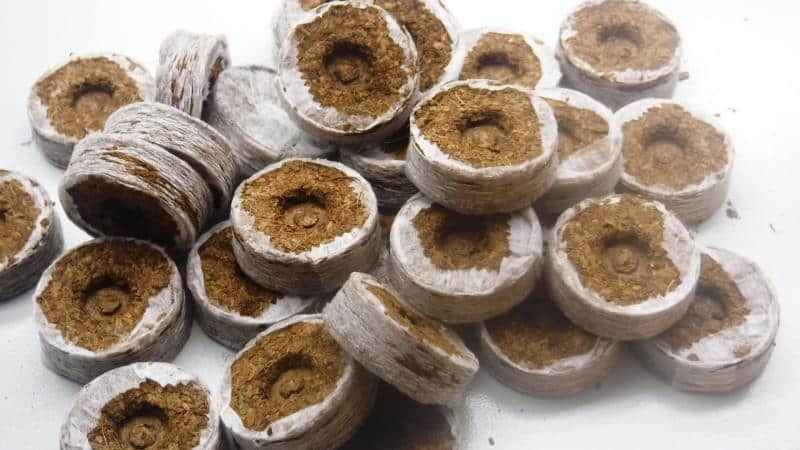
Often gardeners use peat tablets to propagate petunia. They are filled with ideal soil for cultivation. One plant is planted in one tablet. The resulting bag does not have to be removed from the roots even when replanting.
How petunia propagates in peat tablets:
- The tablets are placed in a deep container and poured with a small amount of boiling water. As the liquid is absorbed, hot water is added. When the tablets take the form of bags, they are placed in another container (without water) and allowed to cool.
- One cutting is planted in each tablet. Planting material is buried 2-3 cm.
- The plants are covered with film. Ventilate for 15 minutes daily.
- As the peat dries, it is watered. Water should not get on the leaves of the seedlings.
When new leaves begin to form, the film is removed. Petunia is transplanted directly into peat bags into a large container when the root system fills the entire space.
How to cut petunia for the winter
For winter propagation, at the end of August or beginning of September, the bush is dug up along with a lump of earth and transplanted into a pot, while the plant continues to bloom.
Important! Before bringing the transplanted petunia into the house, it is treated with fungicides and insecticides. This will kill infections and pests.
The flower is stored on the balcony or in another room with a temperature of at least +2°C. His provide additional illumination and watered periodically.
In mid-February, the shoots are cut off and rooted. The procedure is no different from growing seedlings in summer, except that the sprouts will need additional lighting.
Features of cuttings of vegetative petunia
Ampelous and double petunias do not reproduce by seeds. The latter do not even produce them, so such plants are bred exclusively vegetatively.
For terry petunia, the method of rooting cuttings in water is not suitable. It is best to plant it directly in the ground or peat bags.
Further care
When cuttings are carried out in summer, the seedlings are left at home for autumn and winter. It is important to follow the rules of care.
During the cold period, the plant will not have to pay much attention:
- The pots are placed on the eastern windowsill. Seedlings do well at room temperature. They will not die on the balcony if the temperature does not drop below +2°C.
- Water the petunia as the soil dries. Use settled tap or melt water at room temperature. The liquid is poured only at the root, as it should not get on the leaves.
- In winter, the flower will need additional lighting. Its daylight hours are 12–14 hours. Phytolamps are installed at a distance of 20 cm from the plant.
- Fertilizing is applied only if the petunia blooms. The soil is fertilized once every 2 weeks with compounds including phosphorus and potassium.
Advice from experienced flower growers
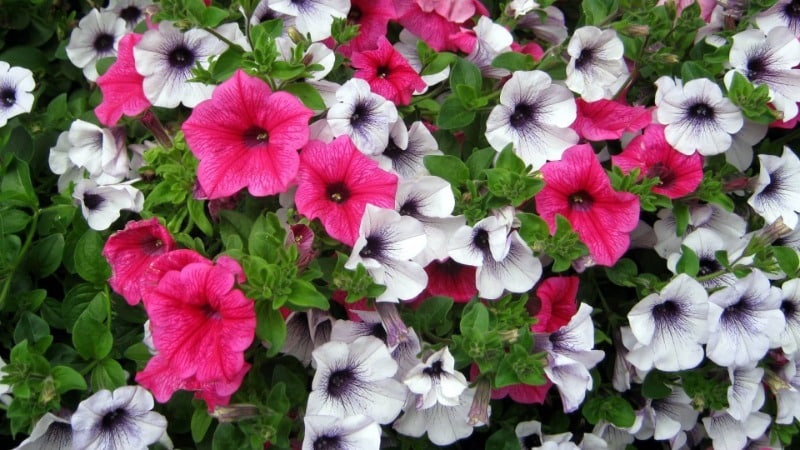
Expert recommendations from experienced gardeners will help you avoid many problems when growing seedlings from cuttings:
- When rooting cuttings in water, coal is replaced with a light pink solution of potassium permanganate.
- To reduce the risk of disease, drainage must be added to the pot.
- It is advisable to use purified or melt water for irrigation. Tap liquid containing chlorine and various chemical impurities will cause roots to rot and leaves to fall off.
- To prevent the plant from getting sick, a soil crust should not be allowed to form. A day after watering, the soil around the flower is loosened. It is convenient to do this with a regular fork.
Conclusion
Propagating petunia by cuttings is the easiest way to grow it. Unlike the generative method, the gardener will not have to pay much attention to caring for the seedlings. In this case, the planting material will produce an exact copy of the mother plant.